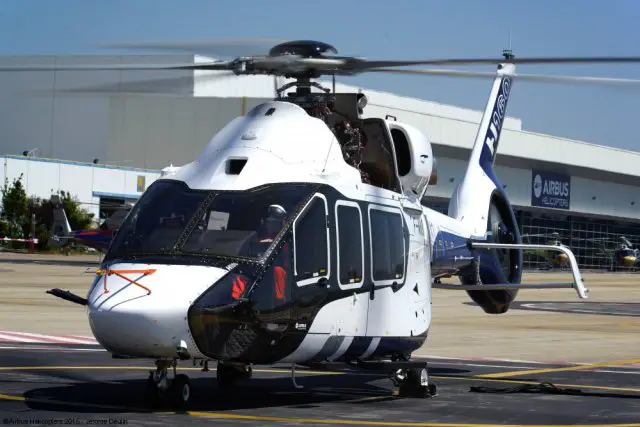Breaking news
Airbus Helicopters officially unveils first prototype of the H160 utility helicopter 3005152.
| a | |||
| |
|||
World
Aviation Defense & Security Industry News - Airbus Helicopters |
|||
| Airbus Helicopters officially unveils first prototype of the H160 utility helicopter | |||
Three
months after having unveiled a mockup of the H160 at Heli-Expo 2015, Airbus
Helicopters has disclosed the first prototype of the aircraft. Airbus
Helicopters unveiled the H160 prototype in the presence of French Prime
Minister Manuel Valls. This innovative helicopter also performed its first
ground run on May 28, 2015, announced Airbus Helicopters. The company
previously reported that the prototype, the first of three, powered on
in November 2014. |
|||
 Airbus Helicopters H160 medium utility helicopter during its first ground run on May 28, 2015 (Airbus Helicopters) |
|||
The
Airbus Helicopters H160 was first revealed to the public in 2011, at which
point it was referred to by company representatives by the designation
X4 - a designation which implied it to be a follow-on from the Eurocopter
X3, a high-speed hybrid helicopter technology demonstrator.
The H160 is the first aircraft to feature the innovation the Blue Edge five-bladed main rotor. This rotor incorporates a double-swept shape that serves to reduce the noise generation of blade-vortex interactions (BVI), a phenomenon which occurs when the blade impacts a vortex created at its tip; this results in a 3-4 dB noise reduction and raises the aircraft's effective payload by 100 kg (220 lb). Aerodynamic innovations include a biplane tailplane stabiliser for greater low speed stability, and a quieter canted fenestron (a feature which originated on the cancelled Boeing–Sikorsky RAH-66 Comanche scout helicopter) which combined produce an extra 80 kg of lift. The H160 shall be powered by two Turbomeca Arrano turboshaft engines; a second engine, the Pratt & Whitney Canada PW210E, was originally intended to be offered as an alternative option, but this was eliminated due to insuffient power output and to reduce design complexity. |
|||



















